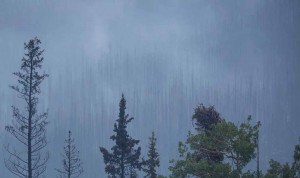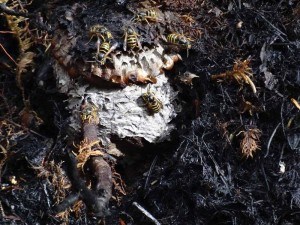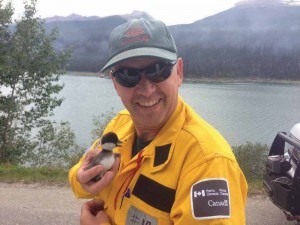

The iconic bald eagle nest on Medicine Lake has passed between generations of birds, its gnarled lattice of sticks in places obscured by the growth of the tree around it.
These days one can see a brown, scruffy-looking eaglet perched on the edge of the nest, at times staring out over the expanse of emerald waters below. He could be the most photographed eaglet ever—a local celebrity though he doesn’t know it. He survived the recent Excelsior Wildfire that torched the trees around him, as he helplessly looked on, not yet able to fly.
In fact, flames licked at the base of the nest tree, charring it halfway up the trunk. So what saved him?
Each fire does its own dance, based on factors like the fuel available to it, terrain, wind and temperature. The moister air next to the lake, and probably some nearby aspen, helped to increase the humidity around the nest, says Parks Canada Conservation Biologist Brenda Shepherd, adding there was also some luck involved as other trees around the nest burned.
Still, given all the smoke and proximity to the heat of the flames, how will the eagle do in the long term?
“The parents returned the next day,” says Shepherd, and are back to feeding the eaglet. It continues to thrive on its nest, fattening on fish, mice and voles as its body prepares for its first flight.
Flight. It’s what most birds do as a fire approaches. Animals in this part of the world have evolved with fire, and generally have strategies to survive it. In this case, fire behaviour made it relatively easy for animals to escape.
“Sometimes [the fire] moved quickly, but not for very long. Generally it moved at about the pace somebody could walk. A lot of wildlife that were mobile could just out-walk it,” says Shepherd, adding the fire moved forward at about three kilometres an hour.
Shepherd says that in addition to simply evacuating, animals have other methods of surviving wildfire. Some, like amphibians, small mammals, and some insects, burrow underground.

Following the fire, Parks Canada’s Mike Wesbrook found a burnt over ground nest of yellow jackets covered with 30 to 40 still buzzing wasps that toughed it out in the duff and lived to sting another day.
Lest the noble eaglet get all the credit, another bird—one tough little goldeneye—was also found waddling down the road post-blaze, along Medicine Lake, and was scooped up by Parks Canada’s James McCormick.
“He knew it was a goldeneye, a water bird,” says Shepherd. Hoping others of its kind might be nearby on the lake, McCormick placed the duckling in one of his work boots to keep it calm, and drove down to the water. Sure enough, the goldeneye family was paddling around the shore. McCormick set the duckling in the water, and watched the reunion as its mother came up and sniffed her baby, then swam away with the full brood.

Goldeneyes are cavity nesters, says Shepherd, explaining that the tree cavities they make their homes in can be quite high up. “Once they’re born, they just kind of drop out of the nest and land in a soft ‘floomp,’ then they head into the water where they continue to develop.
“Their tree may have been burned over,” says Shepherd, explaining that it’s possible the family fled to the water when the fire hit, and lost a duckling along the way.
The fire has come and gone from the Medicine Lake area, and within a week a deer and grizzly bear were spotted in the burn. Already plant life sprouts loud against the black background of charred trees that will crumble away and become the nutrient base for the forest that succeeds them.
The changes will be positive for some species, and potentially less so for others. Areas that have been burned tend to attract deer, elk and moose.
“That can increase the use of that area by predators,” says Shepherd, adding that this may not be a positive for caribou that use adjacent areas.
On the upside, the burned area may attract the olive-sided flycatcher, a bird that is considered a species at risk and prefers barbecued forests for habitat.
“We’ll be looking for olive-sided flycatchers, to see if they return,” says Shepherd, who has been monitoring birds in that area for nine years. “We expect to see real change in the bird community. It will be interesting.”
In the meantime, local fans of the Medicine Lake eaglet will continue to watch him grow, cheering him on, and waiting for the day he will stretch his wings and fly away.
Niki Wilson
Special to the Fitzhugh
